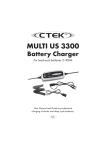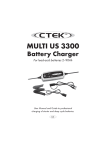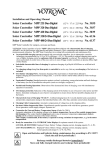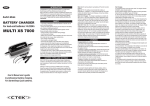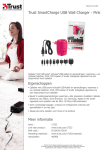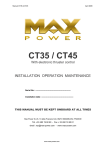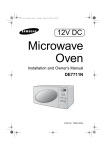Download WeatherTech SmartCharge 200 User manual
Transcript
Battery Charger For lead-acid batteries 2–90Ah User Manual and Guide to professional charging of starter and deep cycle batteries. INTRODUCTION The WeatherTech® SmartCharge 200 is a primary switch mode battery charger with pulse maintenance. The SmartCharge 200 is designed to offer maximum life for the battery. SmartCharge 200 is a member of a family of professional chargers from MacNeil Automotive Products, Ltd.. It represents the state-of-the-art of today’s technology for battery charging. Please read these operating instructions carefully before operating the WeatherTech® SmartCharge 200. IMPORTANT SAFETY INSTRUCTIONS California Proposition 65 WARNING: This product contains chemical known to the state of California to cause cancer or reproductive toxicity. 1. 2. 3. 4. 5. 6. 7. 8. 9. 10. SAVE THESE INSTRUCTIONS – This manual contains important safety and operating instructions for battery charger models WeatherTech® SmartCharge 200. When charging, batteries can emit explosive gases, therefore it is essential to prevent flames and sparks. The charger is designed for charging lead-acid batteries from 2 to 90Ah. Do not use for any other purpose. Always provide good ventilation when charging. Use of an attachment not recommended or sold by the battery charger manufacturer may result in a risk of fire, electric shock or injury to persons. To reduce risk of damage to the electric plug and cord, pull by the plug rather than cord when disconnecting charger. An extension cord should not be used unless absolutely necessary. Use of improper extension cord could result in a risk of fire and electric shock. If an extension cord must be used, make sure that: a) Pins on plug of extension cord are the same number, size and shape as those of plug on charger; b) Extension cord is properly wired and in good electrical condition; and c) Wire size is large enough for ac ampere rating of charger as specified in “technical data”. Do not operate charger with damaged cord or plug – return the charger to the place where purchased. Never operate the charger if it has received a sharp blow, been dropped or otherwise damaged in any way; take it to a qualified serviceman. Do not disassemble charger; take it to a qualified serviceman when service or repair is required. Incorrect reassembly may result in a risk of electrical shock or fire. To reduce risk of electric shock, unplug charger from AC outlet before attempting any maintenance or cleaning. Turning off controls will not reduce the risk. 11. a) WARNING - RISK OF EXPLOSIVE GASES WORKING IN VICINITY OF A LEAD-ACID BATTERY IS DANGEROUS. BATTERIES GENERATE EXPLOSIVE GASES DURING NORMAL BATTERY OPERATION. FOR THIS REASON, IT IS OF UTMOST IMPORTANCE THAT, YOU FOLLOW THE INSTRUCTIONS EACH TIME YOU USE THE CHARGER. b) To reduce risk of battery explosion, follow these instructions and those published by the battery manufacturer and the manufacturer of any equipment you intend to use in vicinity of battery. Review cautionary marking on these products and on engine. PERSONAL PRECAUTIONS 12. a) Consider have some one close enough by to come to your aid when you work near a lead-acid battery. b) Have plenty of fresh water and soap nearby in case battery acid contacts skin, clothing or eyes. c) Wear complete eye protection and clothing protection. Avoid touching eyes while working near battery. d) If battery acid contacts skin or clothing, wash immediately with soap and water. If acid enters eye, immediately flood eye with running cold water for at least 10 minutes and get medical attention immediately. e) NEVER smoke or allow a spark or flame in vicinity of battery or engine. f) Be extra cautious to reduce risk of dropping a metal tool onto battery. It might spark or short-circuit battery or other electrical part that may cause explosion. g) Remove personal metal items such as rings, bracelets, necklaces, and watches when working with lead-acid battery. A lead-acid battery can produce a short-circuit current high enough to weld a ring or the like to metal, causing a severe burn. h) Use charger for charging a LEAD-ACID battery only. It is not intended to supply power to a low voltage electrical system other than in a starter-motor application. Do not use battery charger for charging dry-cell batteries that are commonly used with home appliances. These batteries may burst and cause injury to persons and damage to property. i) Never charge a frozen battery. PREPARING TO CHARGE 13. a) If necessary to remove battery from vehicle to charge, always remove grounded terminal from battery first. Make sure all accessories in the vehicle are off, so as not to cause an arc. b) Be sure area around battery is well ventilated while battery is being charged. c) Clean battery terminals. Be careful to keep corrosion from coming in contact with eyes. d) Add distilled water in each cell until battery acid reaches level specified by battery manufacturer. Do not overfill. For a battery without removable cell caps, such as valve regulated lead acid batteries, carefully follow manufacturer’s recharging instruction. e) Study all battery manufacturer’s specific precautions while charging and recommended rates of charge. f) Determine voltage of battery by referring to car owner’s manual and make sure that the output voltage selector switch is set at correct voltage. If charger has adjustable charge rate, charge battery initially at lowest rate. CHARGER LOCATION 14. a) Locate charger as far away from battery as dc cables permit. b) Never place charger directly above battery being charged; gases from battery will corrode and damage charger. c) Never allow battery acid to drip on charger when reading electrolyte specific gravity or filling battery. d) Do not operate charger in a closed-in area or restrict ventilation in any way. e) Do not set a battery on top of charger. DC CONNECTION PRECAUTIONS 15. a) Connect and disconnect dc output clips only after setting any charger switches to “off” position and removing ac cord from electric outlet. Never allow clips to touch each other. b) Attach clips to battery and chassis as indicated in 16(e), 16(f), 17(b) through 17(d). 16. FOLLOW THESE STEPS WHEN BATTERY IS INSTALLED IN VEHICLE. A SPARK NEAR BATTERY MAY CAUSE BATTERY EXPLOSION. TO REDUCE RISK OF A SPARK NEAR BATTERY: a) Position AC and DC cords to reduce risk of damage by hood, door or moving engine part. b) Stay clear of fan blades, belts, pulleys, and other parts that can cause injury to persons. c) Check polarity of battery posts. POSITIVE (POS, P, +) battery post usually has larger diameter than NEGATIVE (NEG, N, -) post. d) Determine which post of battery is grounded (connected) to the chassis. If negative post is grounded to the chassis (as in most vehicles) see (e). If positive post is grounded to the chassis, see (f). e) For Negative-grounded vehicle, connect POSTIVE (RED) clip from battery charger to POSITIVE (POS, P, +) ungrounded post of battery. Connect NEGATIVE (BLACK) clip to vehicle chassis or engine block away from battery. Do not connect clip to carburetor, fuel lines, or sheet-metal body parts. Connect to a heavy gage metal part of the frame or engine block. Charger connection. 1. Connect positive charger clip (red) to positive battery terminal. 2. Connect negative charger clip (black) to a good metal engine ground away from the battery. Do no connect clip to fuel lines or sheet-metal body parts. 3. Connect the AC cord to the socket. The red alarm indication light will indicate a battery which is connected to reverse polarity. f) For Positive grounded vehicle, connect NEGATIVE (BLACK) clip from battery charger to NEGATIVE (NEG, N, –) ungrounded post of battery. Connect POSITIVE (RED) clip to vehicle chassis or engine block away from battery. Do not connect clip to carburetor, fuel lines, or sheet-metal body parts. Connect to a heavy gage metal part of the frame or engine block. Charger connection. 1. Connect negative charger clip (black) to negative battery terminal. 2. Connect positive charger clip (red) to a good metal engine ground away from the battery. Do no connect clip to fuel lines or sheet-metal body parts. 3. Connect the AC cord to the socket. The red alarm indication light will indicate a battery which is connected to reverse polarity. g) When disconnecting charger, turn switches to off, disconnect AC cord, remove clip from vehicle chassis, and then remove clip from battery terminal. h) See operating instructions for length of charge information. 17. FOLLOW THESE STEPS WHEN BATTERY IS OUTSIDE VEHICLE. A SPARK NEAR BATTERY MAY CAUSE BATTERY EXPLOSION. TO REDUCE RISK OF A SPARK NEAR BATTERY: a) Check polarity of battery terminals. POSITIVE (POS, P, +) battery post usually has a larger diameter than NEGATIVE (NEG, N, -) post. b) Attach at least a 24-inch-long 6-gauge (AWG) insulated battery cable to NEGATIVE (NEG,N,–) battery post. c) Connect POSITIVE (RED) charger clip to POSITIVE (POS, P, +) battery of post. d) Position yourself and free end of cable as far away from battery as possible – then connect NEGATIVE (BLACK) charger clip to free end of cable. e) Do not face the battery when making the final connection. f) When disconnecting charger, always do so in reverse sequence of connecting procedure and break first connection while as far away from battery as practical. g) When disconnecting charger, disconnect in reverse sequence from connecting procedure. See operating instructions for charge information. h) A marine (boat) battery must be removed and charged on shore. To charge it on board requires equipment specially designed for marine use. The battery charger must be connected to the battery according to the instructions above. IMPORTANT SAFETY INFORMATION! The WeatherTech® SmartCharge 200 cannot be used to restore a fully worn out battery. If the SmartCharge 200 does not switch to maintenance charge after three days (green light illuminated), there is a fault. Possible causes: • The battery is probably worn out and should be replaced. • Some large antimony batteries may behave different and can allow the SmartCharge 200 to charge the battery for too long, which can lead to overcharging. See caution! • If heavy power consumers like fitted alarms and navigation computers are connected to the battery, the charging process takes longer and this can also overcharge the battery. • A sulphated battery will only accept current with difficulty, and consequently the charging process takes a particularly long time. A worn out battery cannot be fully charged. Therefore you should always check whether the charger has been switched to maintenance charge before you leave it turned on or unobserved for any length of time. Caution: If the SmartCharge 200 does not switch to maintenance charge mode after three days, manually switch it to pulse maintenance mode. If the set has been switched to maintenance charge, then everything is in order. Note: A battery that hasn’t changed to maintenance charge after three days is most likely worn out and needs to be replaced. All other batteries can be maintained for a very long time. CHARGING Connecting the WeatherTech® SmartCharge 200: Connecting the equipment to a battery fitted in the vehicle: 1. When the battery cable is being connected or disconnected, the plug of the SmartCharge 200 must be disconnected from the power socket. 2. Establish which terminal is ground (connected to the chassis). Normally the negative terminal is grounded. 3. Charging a battery grounded to the negative terminal: Negative-grounded vehicle Charger connection. a)Connect positive charger clip (red) to positive battery terminal. b)Connect negative charger clip (black) to a good metal engine ground away from the battery. Do not connect clip to fuel lines or sheet-metal body parts. c) Connect the AC cord to the socket. The red alarm indication light will indicate a battery which is connected to reverse polarity. 4. Charging a battery grounded to the positive terminal: Positive grounded vehicle Charger connection. a)Connect negative charger clip (black) to negative battery terminal. b)Connect positive charger clip (red) to a good metal engine ground away from the battery. Do not connect clip to fuel lines or sheet-metal body parts. c) Connect the AC cord to the socket. The red alarm indication light will indicate a battery which is connected to reverse polarity. Connecting the WeatherTech® SmartCharge 200 to an out of vehicle battery: 1. Check polarity of battery terminals. POSITIVE (POS, P, +) battery post usually has larger diameter than NEGATIVE (NEG, N, -) post. 2. Connect POSITIVE (RED) charger clip to POSITIVE (POS, P, +) battery post. 3. Connect NEGATIVE (Black) charger clip to NEGATIVE (NEG, N, -) battery post. The red alarm indication light will indicate a battery, which is connected to reverse polarity. 4. Connect charger’s AC cord to socket. 5. Do not face the battery when making the final connection. 6. When disconnecting charger, disconnect in reverse sequence from connecting procedure. See operating instructions for charge information. Starting the charging process 1. Set the correct charge mode by pressing the mode button. You can find out how to select the correct charge mode to be used for charging your battery in the section on “SETTINGS”. 2. Once you have established that the battery cable has been correctly connected you can start the charging process. To do so, insert the charger plug into the AC socket. or the maintenance charge indicator lights 3. Now either the charge indicator up. When the maintenance charge indicator lights up, the battery is fully charged. If the battery voltage drops, the charger sends a pulse to the battery. The length of the pulse depends on how much charge the battery has lost. The SmartCharge 200 may be connected for months at a time. However it is recommended to monitor batteries on charge. 4. If nothing happens: If the indicator for the set voltage is still illuminated, but no other indicator is illuminated, the connection to the battery or the chassis could be faulty, or the battery could be defective. If the charging process has not started, this could be due to the fact that the power socket is not supplying a current. 5. The charging process can be interrupted at any time. In addition pull the plug of the charger out of the power socket or put the charger on Stand-by/Power On . Always remove the plug of the charger from the power socket before disconnecting the battery cable. If you interrupt the charging process of a battery fitted in a vehicle, the battery cable must always be first disconnected from the chassis and then from the other battery cable. 6. If the indicator for charge and maintenance charge are flashing alternately, this may have the following causes: • Interruption of the charging process because a cable has become loose or because the battery is not conducting. • The battery is sulphated. If the indicator flashes for more than 30 minutes the battery may be defective and should be replaced. • If the flashing signal is flashing at intervals of more than 10 seconds, then there is a high self discharge of the battery, indicating a bad battery. BATTERY TYPES AND SETTINGS The WeatherTech® SmartCharge 200 can easily be set for different types of batteries or conditions. The following recommendations should however only be seen as guidelines. Please consult the battery manufacturer for further instructions. Settings are made by pressing the ”MODE-button” and stepping forward one press at a time until the required mode is reached, the button is then released. The selected mode is saved in a memory in the charger and remains there even if the charger is switched off. Mode 14.4V/0.8A This mode is normally used for batteries <14Ah. Mode 14.4V/3.3A Normal setting for wet batteries, maintenance free and for most Gel batteries. Some gel batteries prefer a slightly lower voltage. Please consult the battery manufacturer when in doubt. Mode 14.7V/3.3A This setting is recommended for a battery at temperatures <41°F. It is also recommended for many AGM batteries like Optima, Maxxima and Odysses. Consult your battery manufacturer when in doubt. CHARGING CYCLE The WeatherTech® SmartCharge 200 operates in a four step fully automatic cycle. It starts the charging with an almost constant current (0.8A or 3.3A) until maximum voltage (14.4V or 14.7V) is reached. At this point the charger switches to constant voltage, and the current supply to the battery is gradually reduced. If the current drops to 0.4A, the charger switches to pulse maintenance. If the battery is charged and the terminal voltage of the battery falls to 12.9V, the charger automatically starts again at the first step of the charge characteristic. The SmartCharge 200 measures both voltage and current in order to determine out whether the charging process is finished or whether a new charging cycle must be started. Various methods are used, depending on the time of the measurement; see table: When? Reading Yes No Before the start or after changing the charging mode. Voltage higher than 12.9V? Green indicator lit until the voltage <12.9V. Orange indicator, charging process. During the charging Current greater than Orange indicator, process. 0.4A? charging process. Green indicator illuminated until the voltage <12.9V. Desulphation: Desulphation with pulsing for sulphated batteries. Bulk: Charging where about 80% of the energy is returned. The charger delivers an almost constant current until the battery voltage reaches the set level. Absorption: Charging up to almost 100%. The charge current tapers and the voltage is kept constant at the set level. Pulse: Maintenance charge. The charging process ranges between 95% and 100%. The battery receives a pulse if the voltage falls. This stage will keep your battery in a good condition if it is not being used. BULK CHARGING TIME The table shows the duration of the Bulk step up to about 80% state of charge. The time for the Absorption should be added. Battery size (Ah) Mode Time (h) 2 2–3 8 8–10 14 3–4 50 12–14 90 23–26 INDICATORS Incorrect polarity. Charging process Charging completed. Pulse maintenance. Standby / Power on. Charger ready to use, please select charging function. TECHNICAL DATA Voltage AC120VAC, 60Hz. Output power is reduced at lower input voltage. A perfect charge will still be achieved. Current 1.1A rms Back Current Drain* 1.3mA Charging Voltage Nominal: 12V 14.4/14.7V Ripple** Max 50mV rms, max 0.13A. Charging Current 0.8/3.3A max Ambient Temperature- 4°F to +122°F. Automatic reduction of power at increased ambient temperature. Cooling Natural convection. Do not cover the charger. Charger type Four step fully automatic with pulse maintenance mode. Type of batteries All types of lead-acid batteries. Battery Capacity 2–90Ah Dimensions 61/2 x 23/8 x 11/2 inches (L x W x H) Enclosure Splashproof/Rainproof. Weight 1.1 lbs *) The back current drain is the current that the charger uses from the battery when the wall plug is not connected. The reverse current of the SmartCharge 200 is very low and corresponds to 1Ah per month. **)The ripple wave describes how many disturbances are exhibited by current and voltage. A rippled voltage can cause damage to other equipment connected to the battery. The SmartCharge 200 supplies voltage and current with very low voltage rippling. This increases the life of the battery and ensures that equipment connected to it will not be damaged. Recommended Minimum AWG Size for AC Extension cords Length of cord feet (m) 25 (7.6) 50 (15.2) 100 (30.5) 150 (45.6) AWG Size of cord 18 18 18 16 OVERHEATING PROTECTION The SmartCharge 200 is equipped with overheating protection. In high ambient temperatures the output power is reduced. Do not cover the charger. BATTERY CABLES The SmartCharge 200 is equipped with a set of battery cables with battery terminal clips and one set of battery cable with eyelet terminals. MAINTENANCE The SmartCharge 200 is maintenance-free. The charger must not be opened; doing so will invalidate the warranty. If the power cable is damaged it must be replaced by MacNeil Automotive Products, Ltd. or it’s authorized representative. The charger casing can be cleaned using a damp cloth and mild cleaning agent. Remove the plug from the power socket before cleaning. LIMITED WARRANTY MacNeil Automotive Products, Ltd., issues this limited warranty to the original purchaser of this product. This limited warranty is not transferable. MacNeil Automotive Products, Ltd. warrants this unit for five years from the date of purchase against defect workmanship or material. It is the obligation of the purchaser to forward the unit together with proof of purchase to the manufacturer or its representative with transportation cost prepaid. This warranty is void if the unit is abused, handled carelessly or repaired by anyone other than MacNeil Automotive Products, Ltd. or its authorized representative. MacNeil Automotive Products, Ltd. makes no warranty other than this limited warranty and expressly excludes any implied warranty including any warranty for consequential damages. This is the only expressed limited warranty and MacNeil Automotive Products, Ltd. neither assumes nor authorizes anyone to assume or make any other obligation towards the product other than this limited warranty. CAR ACCESSORIES













